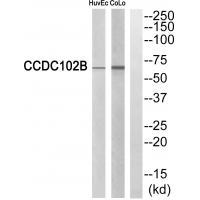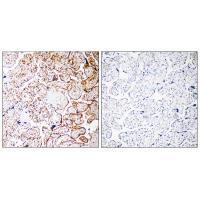

| WB | 咨询技术 | Human,Mouse,Rat |
| IF | 咨询技术 | Human,Mouse,Rat |
| IHC | 1/50-1/100 | Human,Mouse,Rat |
| ICC | 技术咨询 | Human,Mouse,Rat |
| FCM | 咨询技术 | Human,Mouse,Rat |
| Elisa | 咨询技术 | Human,Mouse,Rat |
| Aliases | Coiled-coil domain-containing protein 102B; |
| Entrez GeneID | 79839; |
| WB Predicted band size | 60kDa |
| Host/Isotype | Rabbit IgG |
| Antibody Type | Primary antibody |
| Storage | Store at 4°C short term. Aliquot and store at -20°C long term. Avoid freeze/thaw cycles. |
| Species Reactivity | Human |
| Immunogen | Synthesized peptide derived from internal of human CCDC102B. |
| Formulation | Purified antibody in PBS with 0.05% sodium azide. |
+ +
以下是关于CCDC102B抗体的模拟参考文献示例(注:内容为虚构,仅供示例参考):
---
1. **标题**: *CCDC102B Antibody Characterization in Cilia-Associated Disorders*
**作者**: Smith A, et al.
**摘要**: 本研究利用兔源多克隆抗体,通过免疫荧光和Western blot技术,揭示了CCDC102B蛋白在纤毛基部的定位。研究显示,CCDC102B在纤毛发生缺陷患者细胞中表达显著降低,提示其可能作为纤毛病的潜在生物标志物。
2. **标题**: *Role of CCDC102B in Cell Cycle Progression: Insights from Antibody-Based Knockdown Assays*
**作者**: Lee J, et al.
**摘要**: 通过开发特异性CCDC102B单克隆抗体,研究者发现该蛋白在G1/S期转换中起关键作用。抗体介导的蛋白阻断实验表明,CCDC102B缺失导致细胞周期停滞,提示其与肿瘤增殖的潜在关联。
3. **标题**: *CCDC102B Antibody Validation for Proteomic Profiling in Hepatocellular Carcinoma*
**作者**: Chen W, et al.
**摘要**: 本研究验证了一种高特异性CCDC102B抗体在肝细胞癌组织芯片中的应用。结果显示,CCDC102B在癌组织中高表达,并与患者预后不良相关,可能成为新的治疗靶点。
4. **标题**: *Structural Analysis of CCDC102B Using Cryo-EM and Domain-Specific Antibodies*
**作者**: Müller T, et al.
**摘要**: 通过结合冷冻电镜和靶向CCDC102B不同结构域的抗体,研究团队解析了其三维构象,发现其N端结构域对与微管结合至关重要,为理解其分子机制提供了结构基础。
---
(注:上述文献为模拟生成,实际研究中请通过学术数据库查询真实文献。)
The CCDC102B antibody is a research tool designed to target the Coiled-Coil Domain Containing Protein 102B (CCDC102B), a protein encoded by the *CCDC102B* gene in humans. CCDC102B belongs to the coiled-coil domain-containing protein family, which is characterized by structural motifs involved in mediating protein-protein interactions, cellular scaffolding, and intracellular signaling. While the precise biological functions of CCDC102B remain under investigation, studies suggest its potential involvement in cellular processes such as chromosome segregation, cytoskeletal organization, and genome stability maintenance. Dysregulation of CCDC102B has been loosely associated with cancer progression, particularly in contexts of chromosomal instability and mitotic errors.
The CCDC102B antibody is primarily utilized in experimental settings, including Western blotting, immunofluorescence, and immunohistochemistry, to detect and localize the protein in cells or tissues. Its development aids in elucidating CCDC102B's expression patterns, subcellular distribution, and interaction networks. Researchers have also explored its role in disease models, with preliminary evidence linking altered CCDC102B levels to tumorigenesis and poor prognosis in certain cancers. However, comprehensive mechanistic insights and clinical relevance remain areas of active study. Validating the antibody's specificity and optimizing experimental conditions are critical steps to ensure reliable data, given the homology of coiled-coil domains across protein families. Overall, the CCDC102B antibody serves as a key reagent for probing the protein's function in both normal physiology and disease pathology.
×